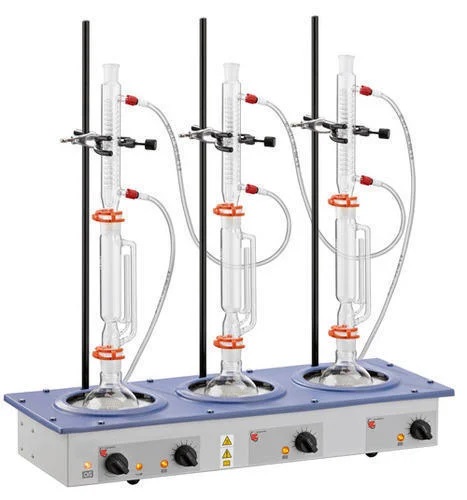
Soxhlet Extraction Unit

A Soxhlet Extraction Unit is a laboratory apparatus used to extract soluble compounds (often lipids, oils, fats, or other desired compounds) from a solid material using a solvent. The process is continuous: solvent vaporizes, condenses, drips over the solid sample, dissolves the solute, and then returns (by siphoning) to the boiling flask — repeating the cycle many times.
Main Components
- Boiling Flask: - Contains the solvent. When heated, the solvent vaporizes.
- Soxhlet Extractor Body: - Has a chamber to hold a thimble (or other container) containing the solid sample. Solvent vapor enters, condenses and drips over the sample.
- Condenser: - Cools the solvent vapour, so it condenses and returns into the extractor chamber.
- Thimble: - A porous, usually filter-paper or cellulose one, which holds the solid sample and prevents solid particles from being washed into the boiling flask.
- Heating System: - Could be a heating mantle, hot-plate, or bath (water or oil) depending on the design. It provides the heat to vaporize the solvent.
- Support Structure / Frame: - Holds up the glassware securely — includes clamps, rods (vertical & horizontal), boss heads etc. Also, often a housing that may offer safety features.
- Control / Regulation:-
- Temperature control (thermostat, PID controller etc.) to maintain the right boiling/reflux conditions.
- Energy or power regulators etc.
- Sometimes timer or automation in more advanced units.
- Cooling Water System:- To circulate water through the condenser to enable condensation of solvent vapours. The flow rate may be specified.
|
Parameters |
Typical Range / Options |
|
Number of parallel tests/positions
|
1, 3, 6 units (for doing more than one sample simultaneously) |
|
Flask size (Solvent/boiling flask) |
~ 50 ml up to several liters depending on size |
|
Sample (extractor chamber) capacity |
Similar to flask – depends on sample volume/rate needed |
|
Max temperature / operating temperature |
Some units go up to ~ 300-450°C for certain solvent systems or special glassware |
|
Solvent recovery / closed system considerations |
Some units are designed to recover > 80-90% of the solvent; some are automated to reduce loss and improve safety. |
|
Power supply |
Often 220-230 V AC, 50/60 Hz in many models; power rating depends on number of units and heating type. |
|
Materials |
Glassware (borosilicate etc.), metal frame (often mild steel), sometimes powder coated or epoxy coated for durability and resistance. |
|
Heating type |
Mantle, hot-plate, or water/oil bath. |